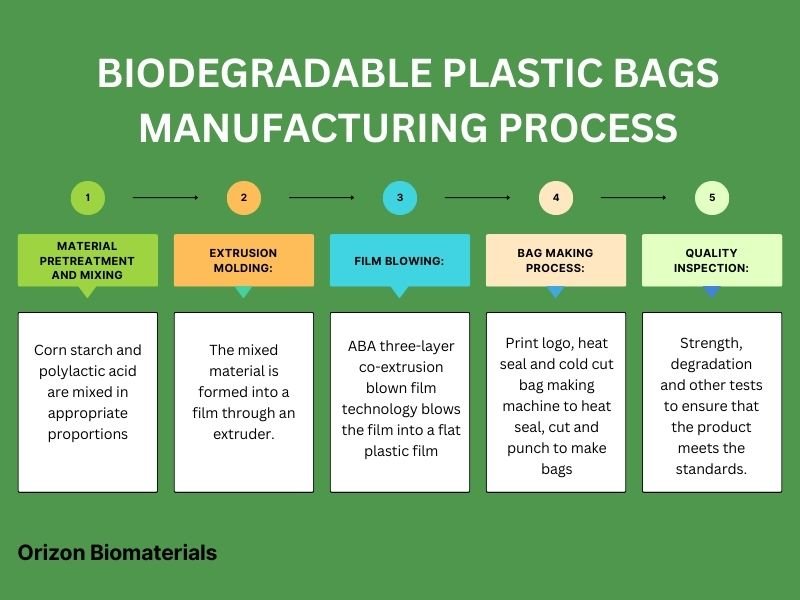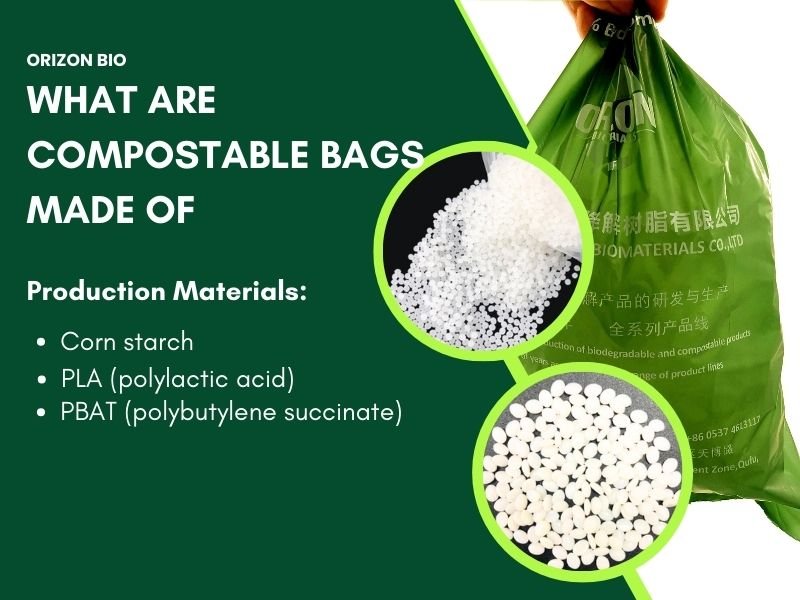Biodegradable and compostable materials are becoming increasingly common in our daily lives. Foreign trade packaging displays “biodegradable for a reduced price” and supermarket shopping bags are even printed with “compostable.” Is biodegradable the same as compostable? What is the difference between biodegradable and compostable? Perhaps you’ve been wondering, but what’s the difference between the two? Is it environmentally friendly? Can you just throw it in the trash?
As a manufacturer of biodegradable and compostable bags with 16 years of experience, today we’ll explain in detail the difference between compostable and biodegradable materials, the differences between biodegradable and compostable materials, and how to handle them. We hope this ultimate guide will help you better understand the difference between the two.
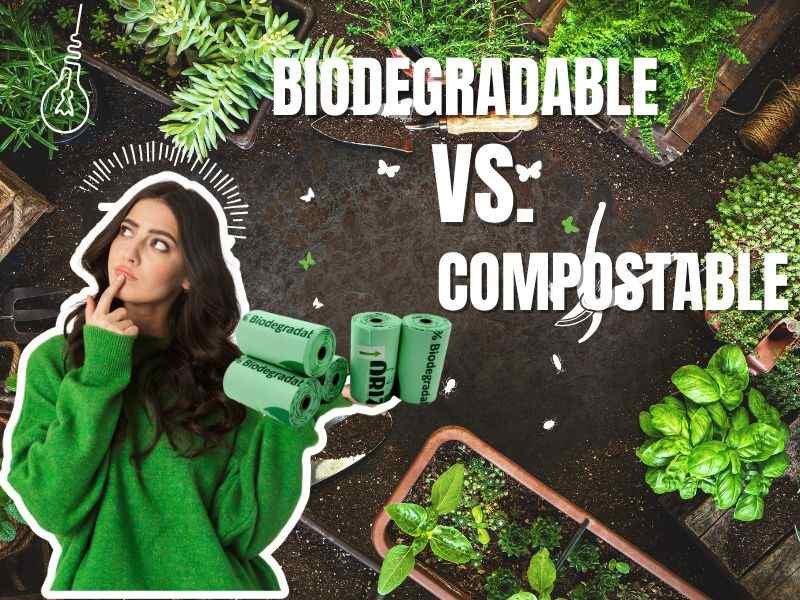
Biodegradable Vs. Compostable
Many businesses now market “biodegradable” and “compostable” products, leading customers to believe that buying them will contribute to environmental protection. In fact, this is not the case. Now let me explain the difference between compost and biodegradable.
What Is Biodegradable?
Biodegradable means something can be broken down by living organisms. It can be consumed by microorganisms in nature, such as bacteria and fungi. Over time, the material turns into water, carbon dioxide, and biomass, potentially taking decades or even centuries to completely disappear from the natural world.
Traditional plastic products are considered “biodegradable,” but they gradually break down into tiny particles—”microplastics“—over a long period of time in nature, posing a serious threat to the environment.
Biodegradable products will eventually break down, regardless of the time or environment, or the specific degree of degradation.
Related Artical: What are Biodegradable Plastic Bags ?2025 Comprehensive Guide
What Is Compostable?
Compostable under certain conditions (such as temperature, humidity, and an active microbial environment), completely decompose into carbon dioxide, water, and organic fertilizer within a specified timeframe, without any environmental impact or plastic residue.
Compostable materials must be processed in specialized industrial composting facilities, where high temperatures and a microbially friendly environment accelerate the decomposition process, with most materials achieving complete decomposition within 90 days.
Compostability requires stricter requirements than biodegradability, requiring a managed and controlled biodegradation process to ensure complete and safe decomposition.

Does Biodegradable Mean Compostable? Does Compostable Mean Biodegradable
Compostable is biodegradable, but biodegradable is not the same as compostable. Biodegradable > compostable. Both biodegradable and compostable products fall under the category of “biodegradable.” To capitalize on the environmental craze, many manufacturers use the term “biodegradable” as a marketing gimmick, misusing it extensively and leading many consumers to mistakenly believe that simply buying a “biodegradable” product will be environmentally friendly.
What Is the Difference Between Biodegradable and Compostable
| Feature | Biodegradable | Compostable |
| Decomposition Conditions | Natural environment, no specific conditions required | Industrial or home composting, requires human intervention |
| Decomposition Time | No specific time limit, could take hundreds of years | Strict time limit (e.g., 90-180 days) |
| Final Product | May leave behind microplastics or toxic residues | Non-toxic, nutrient-rich organic compost (humus) |
| Environmental Value | Uncertain, may even produce methane in landfills | Creates a valuable soil amendment, fostering a circular economy |
| Certification Standards | Virtually no universally recognized standards | Strict international standards (e.g., ASTM D6400, EN 13432) |
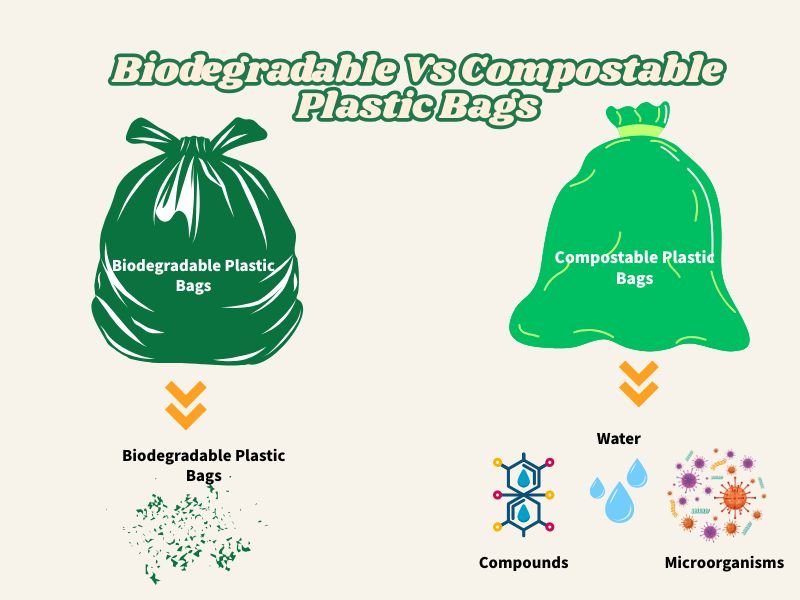
Biodegradable Vs Compostable Plastic Bags: Which One Is More Eco Friendly?
Compostable bags have higher environmental standards, break down faster and more thoroughly, leaving no residue, and are more environmentally friendly. If you can ensure your materials are sent to a suitable composting facility, choosing compostable bags is a surefire choice.
Biodegradable bags come in a wider variety of materials, and their actual degradation times vary greatly. Some bags, while labeled biodegradable, may actually break down very slowly in the natural environment and even leave behind microplastics.
Certification Standards
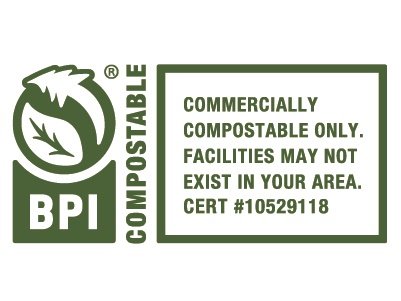
United States and Canada:
- USDA BioPreferred: The closest to biodegradability certification, but the USDA Biobased label is not proof of complete biodegradability.
- The Biodegradable Products Institute (BPI): The most reputable certification body for commercial compostable products (not for home use). It is a third-party certification body; to verify the authenticity of a product, you can check the BPI website for the product identification number. You can find our company identification number on the BPI official website: 10529118.
All of the above certify products according to standards established by ASTM International (formerly the American Society for Testing and Materials). These products are tested to ensure complete decomposition within 180 days and a biodegradable time of one year.
Three ASTM compostability standards:
- ASTM D6400: A baseline test for the compostability of plastics intended for composting in municipal or professional industrial composting facilities. The material must biodegrade “at a rate comparable to known compostable materials” and produce usable compost of uncompromised quality.
- ASTM D6868: Applies to paper materials coated with bioplastic films (e.g., paper coffee cups with waterproof PLA laminate). This ensures the product is compostable in municipal facilities.
- ASTM D6866: Radiocarbon analysis to determine the ratio of a material’s biobased carbon to “fossil carbon” (derived from fossil fuels).
ASTM standards do not certify home compostability, so products cannot be home composted. If such products exist on the market, they are false.
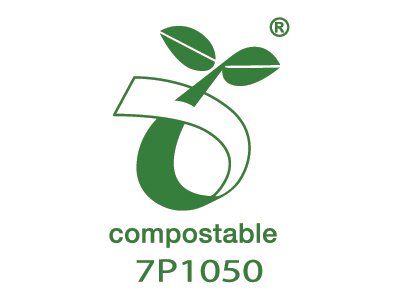
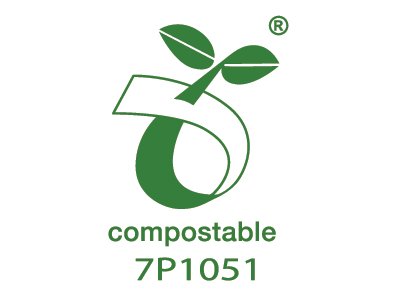
Europe:
The EU does not have a biodegradability certification system. Two standards define compostability:
- EN 13432: Standard for compostable packaging plastics designed to fully degrade in industrial composting plants.
- EN 14995: Extension for plastics used in product packaging.
These standards specify microbial activity (90% biodegradation within 6 months), end-fragment size, ecotoxicity, and chemical analysis (no more than 1% of environmentally harmless compounds and additives).
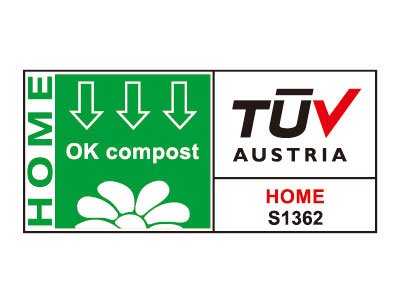
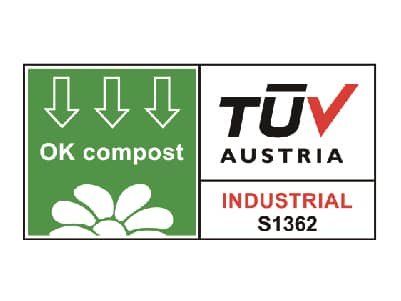
Products meeting EN standards are certified by one of two third-party organizations:
- TÜV AUSTRIA: Offers several different certifications for industrially or home-compostable materials, such as OK Compost Industrial or OK Compost Home.
- DIN Certco: Offers one certification for industrial composting and one for home and garden composting.
Standards are not legally binding in Europe, and there is no obligation to disclose the exact amount of biobased materials in a product.
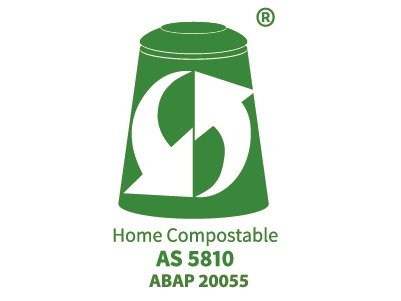
Australia and New Zealand:
Australian Bioplastics has two standards, one for industrial composting of biodegradable materials and the other for home composting:
- AS 4736-2006: Generic standard for commercially compostable and biodegradable plastics.
- AS 5810-2010: Verification that any item, including plastics, can be home composted. It must decompose within six months and fully biodegrade within one year.
How to Dispose of Biodegradable and Compostable Bags?
The “Realities of Compostable Products”
When we have a cup labeled “compostable,” which bin should we dispose of it in? Professional industrial composting facilities are currently unavailable in China, and the concept of composting is still relatively unknown.
If we dispose of it incorrectly, the consequences could be even worse than with ordinary plastic:
- Throw it into the “recyclables” bin? This creates a significant workload for the sorting personnel, as it’s not PET or PP plastic. In the recycling system, bioplastics are contaminants, impacting the overall quality of plastic recycling.
- Throw it into the trash or send it to a landfill? This is likely the worst option. Deep in a landfill, there’s insufficient oxygen. These “compostable” materials decompose in an oxygen-depleted environment, producing large amounts of methane, a “super greenhouse gas.”
- Send it to be incinerated? The point of paying such a high price for it would be completely negated, and the environmental benefits of returning to the soil and promoting a circular economy would become empty talk.
- Home composting environments are suboptimal, with temperatures not high enough for efficient degradation.
- Degradation times vary widely in natural environments, such as the ocean, soil, and landfills, and complete decomposition can take years.
- Plastic waste in the ocean is a serious problem, and biodegradable plastics are simply not suitable for direct disposal into the ocean, as they contribute to pollution.
How to Properly Dispose of Biodegradable Versus Compostable Bags
- Understand your local waste sorting policies.
Search your city’s “Waste Sorting Guide” or “Environmental Protection” app to find out what the official regulations are.
- Make a “second-best” decision based on your circumstances.
If there’s an industrial composting facility, feel free to dispose of it with other waste in the [Food Waste/Wet Waste] bin.
If you’re unsure, or if you’re certain there’s no industrial composting facility locally, dispose of it in the [Dry Waste/Other Waste] bin.
While this won’t yield compostable value, it will avoid contaminating recyclables and generating significant methane in landfills. Given the current lack of infrastructure, incineration is the “least-cost” option.
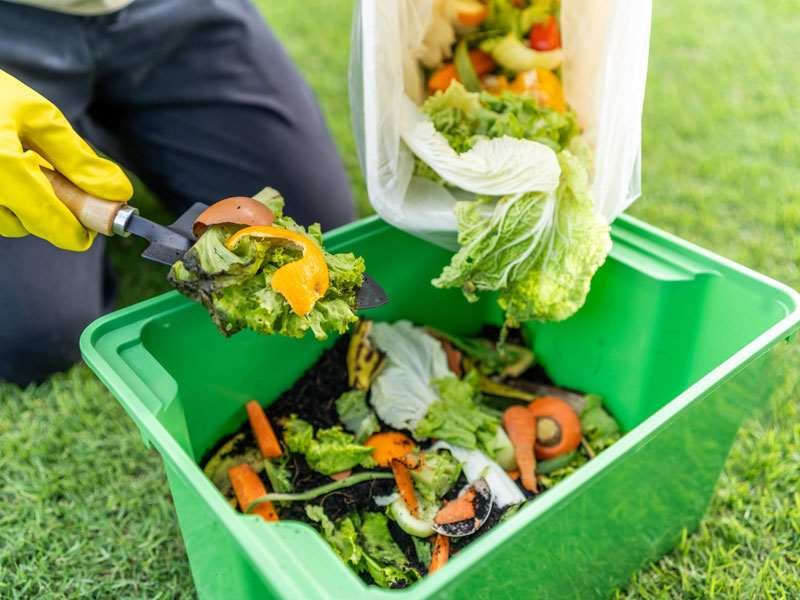
How to Compost
Home Composting Vs. Industrial Composting
Try home composting. Most products labeled “compostable” on the market are industrial composting, not home composting.
- Home composting: The temperature is lower, typically 30-40°C, and the environment is more gentle.
- Industrial composting: The temperature is much higher, reaching 55-70°C, and there are strict humidity and microbial controls.
Transparent bioplastic PLA (polylactic acid) requires industrial-grade heat to break down. If you throw it in your backyard compost bin, it might not change for a year.
Products clearly marked with the “OK compost HOME” certification mark on the packaging are truly compostable and can be composted with confidence.
How to Use a Home Composting Bin
Materials:
A compost bucket or wooden box with a lid, gloves, and a compost shovel.
Compostable Products:
- “Brown Matter” (Carbon): Dry leaves, shredded cardboard, and old newspapers.
- “Green Matter” (Nitrogen): Kitchen scraps such as coffee grounds, fruit peels, vegetable leaves, and tea leaves.
How to Compost
- “Sandwich Method”: Layer “brown matter” followed by a layer of “green matter,” alternating layers like a sandwich.
- Keep the compost moist, like a wrung-out sponge.
- Stir once a week to allow air circulation and accelerate decomposition.
Products Not Suitable for Home Composting:
Meat, fish, bones, dairy products, and greasy foods (they can cause odor and insects). Pet feces and sick plants. “Compostable” packaging without the “OK compost home” logo!
Biodegradable Vs. Compostable Bags: How to Choose for Your Business
| Material | PLA (Polylactic Acid) | CPLA (Crystallized PLA) | PHA (Polyhydroxyalkanoates) | Bagasse (Sugarcane Fiber) |
| Properties | Transparent, rigid & brittle, feels like conventional plastic | Opaque, good heat resistance | Flexible, marine-degradable, a “star” material of the future | Paper-like texture, natural off-white, grease & water-resistant |
| Heat Resistance | Poor (<55°C / 131°F) | Good (<90°C / 194°F) | Moderate | Excellent |
| Cost | Medium | Medium-High | High | Low |
| Common Applications | Cold cups, salad containers, clear packaging | Hot cup lids, cutlery, coffee stirrers | High-end flexible packaging, medical applications | Plates, bowls, clamshell containers, takeaway boxes |
How to Apply for Compost Certification
Want your product to gain international recognition and avoid consumer accusations of greenwashing? Applying for reputable certification is a wise move.
You’ll need to consult a BPI or TÜV AUSTRIA-accredited laboratory and have your product tested. The lab will simulate an industrial composting environment, continuously monitoring its decomposition, toxicity, and other conditions over several months. Only after passing all tests will you receive certification.
Of course, this certification comes with a fee and a waiting period of at least several months. This represents not only a significant cost for your product but also a significant investment in your brand reputation and supply chain stability.
The specific certification materials required are as follows:
- BPI Certification Certification Docs:https://bpiworld.org/certification-docs
- TÜV AUSTRIA industrial Certification Process:https://en.tuv.at/ok-compost-industrial-en/
- TÜV AUSTRIA industrial Certification Process:https://en.tuv.at/ok-compost-home-en/
FAQ
Is Biodegradable the Same as Compostable
“Does biodegradable mean compostable?” “Can I put biodegradable materials in my compost? If so, what kind?” If it’s purely organic, biodegradable and compostable are the same, but since the term “biodegradable” is rarely used for such items, it’s not.
When it comes to biodegradable packaging versus compostable packaging or plastics, there are very different key factors. These include the speed of decomposition and the requirement to leave no toxic residue—a requirement that is largely unattainable, and biodegradable plastics are contributing to our microplastic crisis.
Are biodegradable products necessarily environmentally friendly?
Not necessarily. Some products, even labeled biodegradable, may decompose very slowly and even produce microplastics, still negatively impacting the environment.
What’s the difference between PLA and PET plastic?
PLA is a bio-based, compostable plastic (derived from plants like corn and sugarcane), while PET (the material used in mineral water bottles) is a petrochemical-based, recyclable plastic (derived from petroleum).
One is “from nature, back to nature” (needs composting), while the other is “from resources, back to resources” (needs recycling).
Are products labeled “Oxo-degradable” environmentally friendly?
Absolutely not! This is a form of “pseudo-environmentalism.” Additives cause plastic to break down into countless invisible microplastics, which are even more harmful to soil and oceans and have been banned in the EU and other regions.
Can compostable and biodegradable products be recycled directly?
Putting them in regular recycling bins is not recommended. Compostable products should be taken to a composting facility or home composted to avoid contaminating the recycling system.
Conclusion
What Is the Difference Between Biodegradable and Compostable? You should understand this clearly. When purchasing eco-friendly products, be sure to carefully examine labels and certifications, especially those labeled “compostable.” Find out if local waste disposal facilities accept these materials for recycling. Avoid vague terms like “biodegradable” and be sure to understand the product’s specific degradation time and required environment.
Environmental protection isn’t simply about whether a product can be degraded; understanding the ingredients and production process is equally important. Only by considering all aspects can you make truly environmentally responsible choices.
References
- Microplastics: A Real Global Threat for Environment and Food Safety: A State of the Art Review [pmc.ncbi.nlm.nih.gov]
- BPI Certification : [BPI]
- TÜV AUSTRIA :[OK compost]
- Wikipedia : Polylactic acid [https://en.wikipedia.org/wiki/Polylactic_acid]
- Nature: Polyhydroxyalkanoates: opening doors for a sustainable future [https://www.nature.com/articles/am201648]

